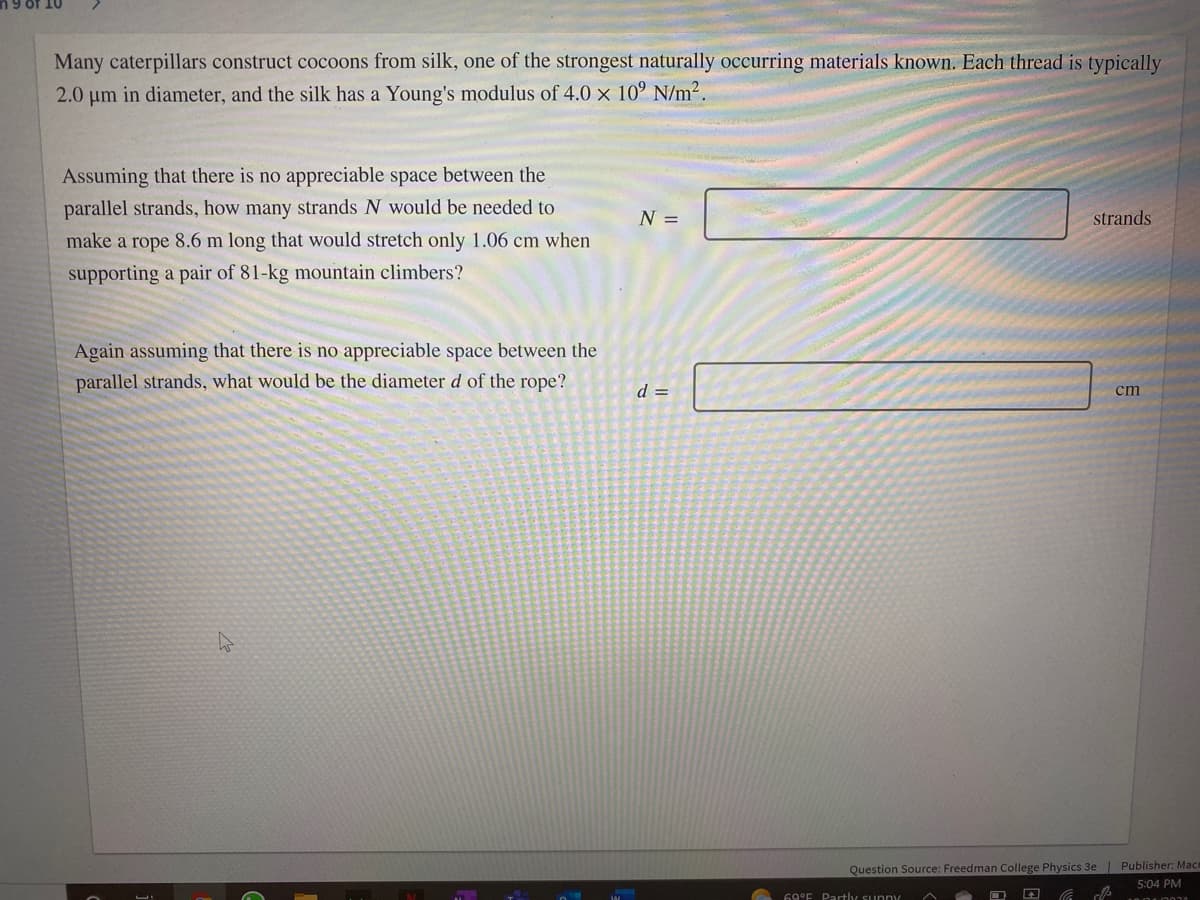Many caterpillars construct cocoons from silk, one of the strongest naturally occurring materials known. Each thread is typically 2.0 µm in diameter, and the silk has a Young's modulus of 4.0 x 10° N/m2. Assuming that there is no appreciable space between the parallel strands, how many strands N would be needed to N = strands make a rope 8.6 m long that would stretch only 1.06 cm when supporting a pair of 81-kg mountain climbers? Again assuming that there is no appreciable space between the parallel strands, what would be the diameter d of the rope? d = cm
Many caterpillars construct cocoons from silk, one of the strongest naturally occurring materials known. Each thread is typically 2.0 µm in diameter, and the silk has a Young's modulus of 4.0 x 10° N/m2. Assuming that there is no appreciable space between the parallel strands, how many strands N would be needed to N = strands make a rope 8.6 m long that would stretch only 1.06 cm when supporting a pair of 81-kg mountain climbers? Again assuming that there is no appreciable space between the parallel strands, what would be the diameter d of the rope? d = cm
Physics for Scientists and Engineers
10th Edition
ISBN:9781337553278
Author:Raymond A. Serway, John W. Jewett
Publisher:Raymond A. Serway, John W. Jewett
Chapter12: Static Equilibrium And Elasticity
Section: Chapter Questions
Problem 27AP: The lintel of prestressed reinforced concrete in Figure P12.27 is 1.50 m long. The concrete encloses...
Related questions
Question

Transcribed Image Text:Many caterpillars construct cocoons from silk, one of the strongest naturally occurring materials known. Each thread is typically
2.0 um in diameter, and the silk has a Young's modulus of 4.0 x 10° N/m².
Assuming that there is no appreciable space between the
parallel strands, how many strands N would be needed to
N =
strands
make a rope 8.6 m long that would stretch only 1.06 cm when
supporting a pair of 81-kg mountain climbers?
Again assuming that there is no appreciable space between the
parallel strands, what would be the diameter d of the rope?
d =
cm
Question Source: Freedman College Physics 3e | Publisher: Mac
5:04 PM
69°E Partly sunny
Expert Solution
This question has been solved!
Explore an expertly crafted, step-by-step solution for a thorough understanding of key concepts.
This is a popular solution!
Trending now
This is a popular solution!
Step by step
Solved in 3 steps with 2 images

Knowledge Booster
Learn more about
Need a deep-dive on the concept behind this application? Look no further. Learn more about this topic, physics and related others by exploring similar questions and additional content below.Recommended textbooks for you

Physics for Scientists and Engineers
Physics
ISBN:
9781337553278
Author:
Raymond A. Serway, John W. Jewett
Publisher:
Cengage Learning

Physics for Scientists and Engineers with Modern …
Physics
ISBN:
9781337553292
Author:
Raymond A. Serway, John W. Jewett
Publisher:
Cengage Learning

Physics for Scientists and Engineers: Foundations…
Physics
ISBN:
9781133939146
Author:
Katz, Debora M.
Publisher:
Cengage Learning

Physics for Scientists and Engineers
Physics
ISBN:
9781337553278
Author:
Raymond A. Serway, John W. Jewett
Publisher:
Cengage Learning

Physics for Scientists and Engineers with Modern …
Physics
ISBN:
9781337553292
Author:
Raymond A. Serway, John W. Jewett
Publisher:
Cengage Learning

Physics for Scientists and Engineers: Foundations…
Physics
ISBN:
9781133939146
Author:
Katz, Debora M.
Publisher:
Cengage Learning

Physics for Scientists and Engineers, Technology …
Physics
ISBN:
9781305116399
Author:
Raymond A. Serway, John W. Jewett
Publisher:
Cengage Learning

University Physics Volume 1
Physics
ISBN:
9781938168277
Author:
William Moebs, Samuel J. Ling, Jeff Sanny
Publisher:
OpenStax - Rice University